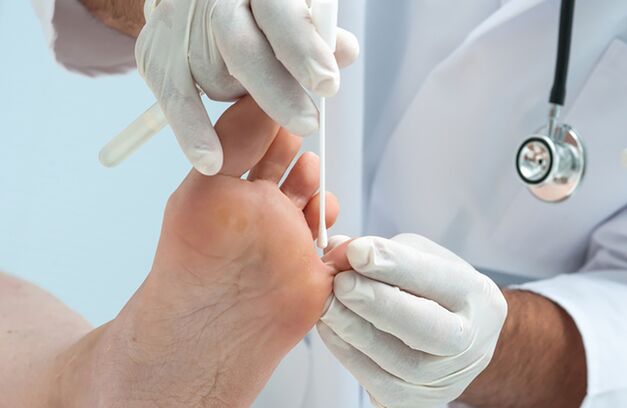
Treatment of fungal diseases should be done under the supervision of a dermatologist.Incorrectly selected antifungal agents can only lead to temporary improvement without healing the disease itself.
The treatment of fungal diseases must necessarily suffer under the supervision of a dermatologist.In case of self -medication, incorrectly selected antifungal agents can only lead to temporary improvement without healing the disease itself.
When choosing the method of therapy, it is necessary to consider the area and form of damage, the rate of fungal spread, the presence of concomitant diseases, the patient's age.
Antifungal drugs are divided into two types: for external and internal use.External agents themselves are effective only in the early stages of the disease, then the treatment should be complex: fungi should be acted outward and internally.
Domestic medicine
For successful and safe treatment of fungal diseases, it is advisable to adhere to certain rules with internal antifungal medicines:
- The diagnosis should be confirmed by a doctor.
- For the period of treatment with internal antifungal medicines, it is advisable to limit the use of other medicines, with the exception of life.
- Medicines should be used under the supervision of a doctor for a long time until the fungus completely disappears.
- Control exams should be performed first once every 2 weeks, then once a month.Scraping Control - 6 months after the treatment is completed.When you detect the fungus, a new treatment is needed.
Currently, dermatologists consider pulse therapy as the most effective and safe method of treatment by taking a long -range drug.In some cases, a 1-week course of therapy is determined, after which follows a 3-week break and then a new seven-day treatment course.During taking, the medicine accumulates in the body, and in the following weeks continues to actively fight the infection.
The full course of therapy is usually created for three months.However, after its completion, the medicine continues to operate during the year, protecting the fungus from the re -effect.This technique, on the one hand, enables the body to "cease" by taking the drug, on the other hand, does not rule out the possibility of taking other medicines, including antibiotics.Moreover, the risk of relapse is significantly reduced.
External medicine
With nail damage, not only internal medicines but also in local medicines - nail polishes and keratolytic pieces and ointments to remove keratinized areas of the skin.
While antifungal spray is used, those that can penetrate the deep layers of the nail and the nail bed.The cabbage is applied to the cut peaks on top (the affected surfaces of the nail can be removed using a nail file attached to the spray), cleaned and low (for example, using alcohol) nail.
Moreover, keratolytic and plaster ointments can be used to remove the affected area of the nail.These products soften the nail, as a result of which it is easily and painlessly removed from the nail bed surface.Patching is currently used as a keratolytic component or salicylic acid.Sometimes an antiseptic or local antifungal agent is added to the patch composition.
A piece of keratolytic is applied to the nail surface and closed with a waterproof and bandage.After 2-3 days, the affected areas are cleaned and the pieces are glued again.The procedures are performed daily until the affected nails are completely removed.The average duration of treatment is 6 months for nails in the hands and 9-12 months for nails in the legs.
Moreover, special nail treatment groups are produced, which usually includes an oil that at the same time has an antifungal and keratolytic effect, a nail scraper and a patch.
For fungal skin lesions, local creams are used.The cream is applied daily in the affected areas.The average duration of treatment is 2-3 weeks;In the treatment of feet - up to 6 weeks.
Processing of infected things (disinfection)
In this process and after treatment of fungal infection, it is very important to disinfect everything the fungus has come into contact.Disinfection should undergo floors, walls, bathroom inventory, showers, bathrooms, as well as patient items: interiors, shoes, skin care items and nails.
The walls and bottom of the bath should be treated with a diluted mixture in the consistency formed by the cream from equal parts of washing powder and chlorine or the dust (the dust must be washed after 30 minutes).You can also use a 5% solution of chloride or lime of chlorine, or a 3% lysol solution.
Shoes are recommended to be treated with formal (25%) or acetic acid (40%).It should be completely wiped with a hydrated buffer bed and side sections of the shoe.Then put the piping on the foot of the shoe and place the shoes yourself in a cellophane bag hermetically tied for 24 hours.After using acetic acid or a 25%formal solution, the shoes are ventilated or wiped with ammonia to destroy the smell.
Female underwear, socks, socks, tanga can be disinfected from 15-20 minutes by boiling in a 2% soap solution.Then they should be ironed with a hot iron.
Manicure scissors are disinfected, immersed in alcohol and then burning on the burning flame.
PREVENTION
To prevent infection with fungi, it is recommended to follow the following rules:
- Use only your shoes.
- Do not wear stolled shoes in which a wet environment is preserved, and the skin and nails undergo friction and microter.
- Shoe care, after dressing shoes should be well dried.
- It is recommended to use local antifungal agents (ointments, creams, varnish) for people who often visit saunas, swimming pools, baths, sports and gym.
- Reject porous carpets in the bathroom - they are poorly washed and therefore serve as a great shelter for a variety of microorganisms, including fungi.















